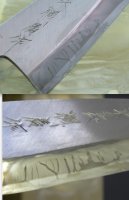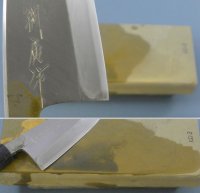Just wondering if any of you gents have had the same experience or could possibly give a bit of insight.
Two of my jnats have a similar reaction though this one much more so.
The stone in question is an Aiiwatani San from Maksim, a very very fast stone with slurry, darkening straight away.
If I stop honing and leave the slurry for even a short time it quickly turns light brown as (I assume) iron oxide forms.
Only 2 of my jnats do this, and I have had one coticule in the past which has a similar reaction.
Is this simply a case that the steel being removed is of such fine particle size that it oxidises rapidly due to high surface area, or could it be something potentially corrosive within the stone which is forcing oxidation.
I have not noticed any rusting of the edges honed on the stone, though I probably don’t leave slurry / water on them long enough anyway.




Anyone had a similar experience ?
Thanks in advance
Rob
Two of my jnats have a similar reaction though this one much more so.
The stone in question is an Aiiwatani San from Maksim, a very very fast stone with slurry, darkening straight away.
If I stop honing and leave the slurry for even a short time it quickly turns light brown as (I assume) iron oxide forms.
Only 2 of my jnats do this, and I have had one coticule in the past which has a similar reaction.
Is this simply a case that the steel being removed is of such fine particle size that it oxidises rapidly due to high surface area, or could it be something potentially corrosive within the stone which is forcing oxidation.
I have not noticed any rusting of the edges honed on the stone, though I probably don’t leave slurry / water on them long enough anyway.
Anyone had a similar experience ?
Thanks in advance
Rob



